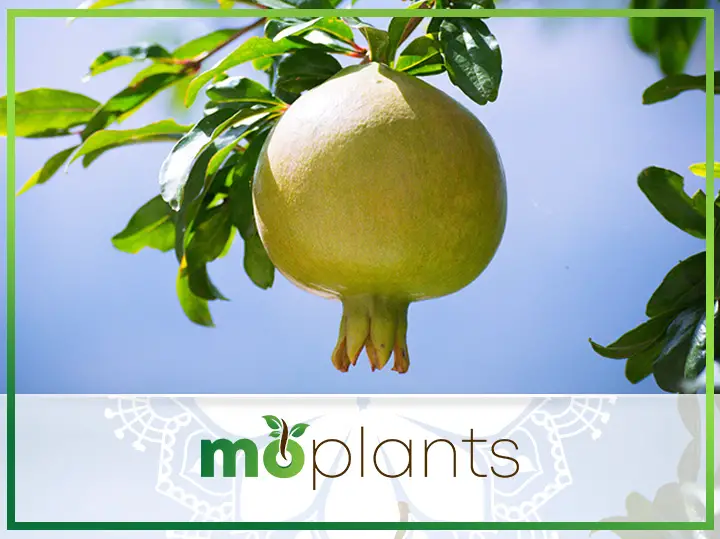Punica granatum is the scientific name for the pomegranate, which is a kind of deciduous shrub or small tree. The plant produces a fruit similar to a berry but with an aril so thick it can hold roughly 600 crimson seeds. Both its medicinal and culinary potential has sparked much research into pomegranate nutrition. Clinical investigations have shown that pomegranate juice may decrease blood pressure, prevent infections, and even cut the chance of getting heart disease and cancer.
If your pomegranate tree leaves are turning yellow, don’t panic. It isn’t that unusual, and there are very easy solutions to it before you give up on the tree altogether. There are many reasons why pomegranate tree leaves can start yellowing, even if you feel like you’ve been taking care of them the way you’re supposed to. In this guide, you’ll learn how to prevent yellowing leaves on your tree as well as how to salvage the tree if they’ve already turned yellow.
Overwatering
Even while pomegranate trees may survive with little care, they’re not invincible.
o find out what’s wrong with your tree, pay attention to the clues provided by the yellowing of its leaves. Overwatering is the main leading cause of pomegranate leaf yellowing, even more, common than seasonal shifts. It’s only natural to want to take care of your fruit trees, but pomegranates are used to dry places and can’t handle a lot of moisture. Leave them to dry out entirely between waterings, and don’t over-mulch or compost the root zone.
When it’s warmer out, you should water more often. Watering should never be more often than every other day, even in the warmest heat. Insufficient water may cause temporary problems with many fruit trees, including the yellowing and dropping of leaves. Give the plant time to react if these limbs are still flexible and healthy.
Yellowing Leaves In The Winter
When the weather becomes cold, do pomegranate trees drop their leaves? Like their deciduous relatives, pomegranates have a distinct seasonal pattern, even though it doesn’t begin until much later in the year. Your tree may be preparing for its winter dormancy if you observe its leaves turning yellow as the weather gets cooler but no other symptoms of stress.
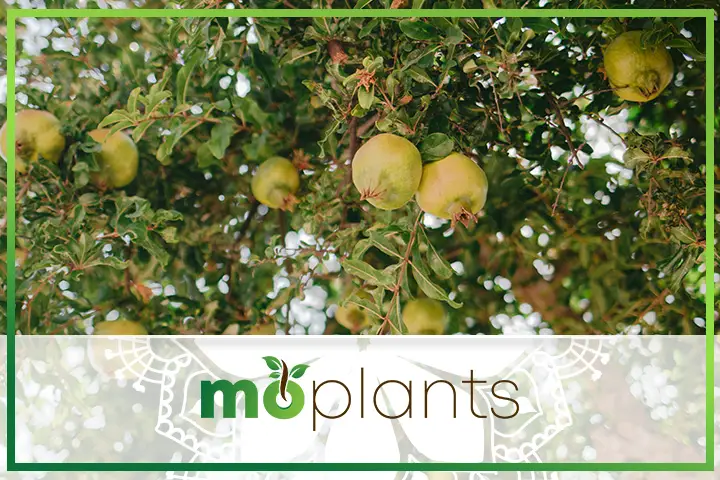
Diseases, Soil, And Pesticides
Overwatering and cold temperatures aren’t the only causes of yellowing leaves. Sometimes diseases, poor soil conditions and pesticides can cause yellowing leaves too.
First, There Are Whiteflies
The female whitefly chooses to deposit her eggs on the underside of the leaves. Larvae hatch, feed on the plant’s sap, and then secrete honeydew as a byproduct. When sooty mold grows on honeydew, it causes the leaves to become yellow and the plant to stop growing. Triazophos 40 EC should be applied to the tree every eight to ten days until symptoms disappear.
Then, You’ve Got Aphids
These are little, yellowish-green insects that sit on the leaf’s underside and create yellow spots. Sticky yellow traps should be hung close to the growing fruit. Use a spray nozzle on your garden hose to treat the lower half of the leaves. Every 15 days, spray with dimethoate or malathion as directed.
To a greater or lesser extent, alkaline soils
Leaves of pomegranates may develop chlorosis, turn yellow, and fall off if they are unable to absorb sufficient amounts of iron, magnesium, and zinc from the alkaline soil typical of most of Arizona. In the absence of insect damage, a lack of nutrients is likely to blame.
Emerging outer leaves are the first to show symptoms of iron deficiency. Fertilize the soil with iron chlorate as instructed. If a plant is lacking in zinc or magnesium, the older, inner leaves will wilt first. Use an acidic, well-balanced fertilizer. Reduce the soil’s acidity by mixing in some compost or peat moss that has been dampened with water.
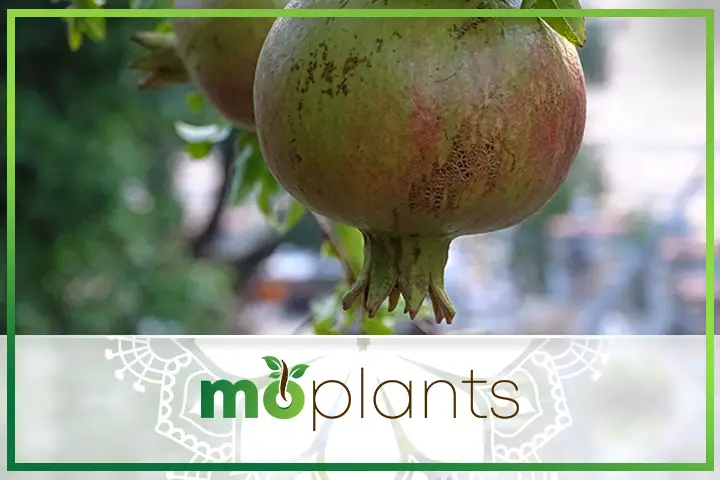
Some Weed Killers
The yellowing of leaves may be caused by insufficient nitrogen in the soil. If the trees and grass are competing for the same supply of nitrogen, it may happen.
However, if you fertilize your lawn often, some of that nitrogen will undoubtedly get up in your pomegranates. Removing grass from around the tree (at a distance of 3 feet) increases the availability of all fertilizers, but nitrogen in particular.
Next, we’ll look at the most probable cause of the issue: weed killers. Putting plastic over the trees before spraying was a good idea. It is even more critical that you use this weed killer under the ideal conditions, such as when the weather is cool and there’s no breeze. Dandelion killers like 2, 4-D volatilize (convert into a vapor) on hot soil surfaces, making them readily dispersed by even the smallest breeze.
When a plant has been damaged by 2, 4-D and is developing new leaves, those leaves will be abnormal. Without new growth, the plant’s old leaves will eventually turn yellow and fall off.
Infographic
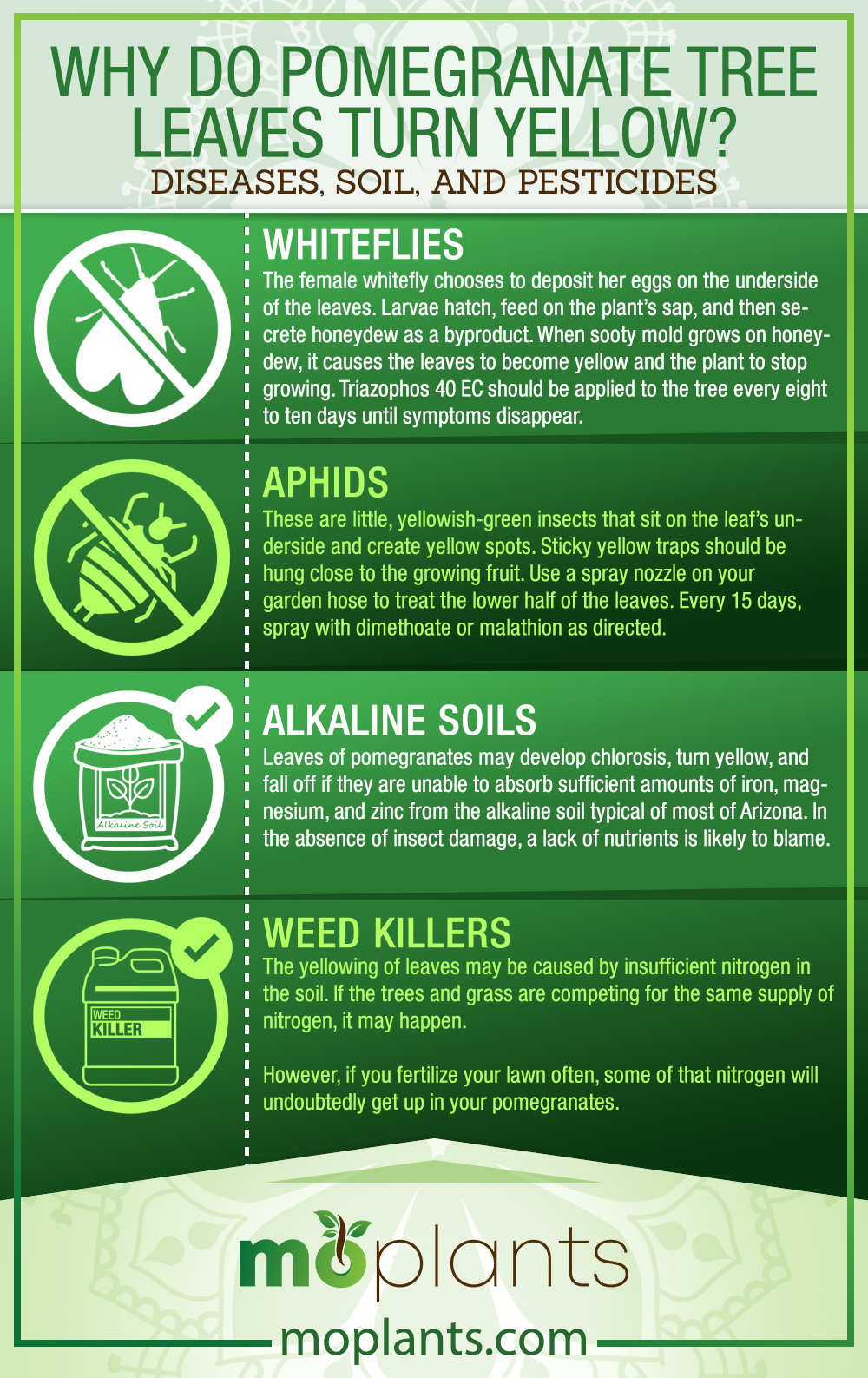
Should You Cut Yellow Leaves Off?
You may cut off any yellow leaves that are bothering you, but it isn’t required. You should investigate the cause of the yellowing leaves if you see a significant increase in their number. Even if your plants have been growing on the earth for quite some time, their appearance may be deceiving. Overwatering is likely the cause of these symptoms.
There hasn’t been enough water for your plant to flush off the extra moisture that has accumulated over the years if the areas are dark. The need to check the plant water levels and re-water them may also be indicated.
Can The Leaves Turn Green?
Chlorophyll provides the leaf its characteristic green hue. Chlorophyll loss signals the end of a leaf’s usefulness to the plant, and the plant will begin to use any remaining nutrients in the leaf for growth. Once a leaf goes yellow, it will never return to its original green color. Similarly, when a plant is unable to photosynthesize, it will die because it cannot get the nutrients it requires. This is why many plants’ dying leaves become yellow.
How Will You Know If The Tree Is Dying?
Mushiness in the stem indicates advanced decomposition. Green and wetness are promising indicators. When a tree’s bark becomes dark and brittle, that means it’s already dead. Generally speaking, dried out leaves indicate a plant has died. Check for these telltale indicators of impending death: A dead tree with dead leaves, lifeless twigs, and dead branches.
The first symptom of a dying tree is usually its branches falling off. Though it may seem to have been severed, the dying branch may still be connected to another branch or twig. Sometimes it seems as if the branch has broken in two. The whole tree, rather than just a single limb, has been destroyed, generally by an illness or insect infestation.
Bugs and fungi that feast on wood leave behind areas that look greenish brown. The trunk of your tree, which is often covered with dead wood, is another good place to search for these places.
What About When They Turn Brown?
Deficiencies in essential micronutrients – Insufficient calcium and magnesium in the soil may lead to foliar diseases in pomegranates. Low amounts of calcium and magnesium cause browning and inward curling of leaf tips. The color of the leaves is quite deep, almost black. Inadequate levels of vitamin B-12 might cause this symptom.
Caused by a shortage of something like the vitamin A component retinyl palmitate, vitamin A insufficiency manifests itself in a variety of ways.
Both leaves and stems of numerous fruits and vegetables are rich in retinyl. It’s a necessary step in the process of making the active component in retinol, a skin-lightening agent found in many cosmetics and personal care products: retinoic acid.
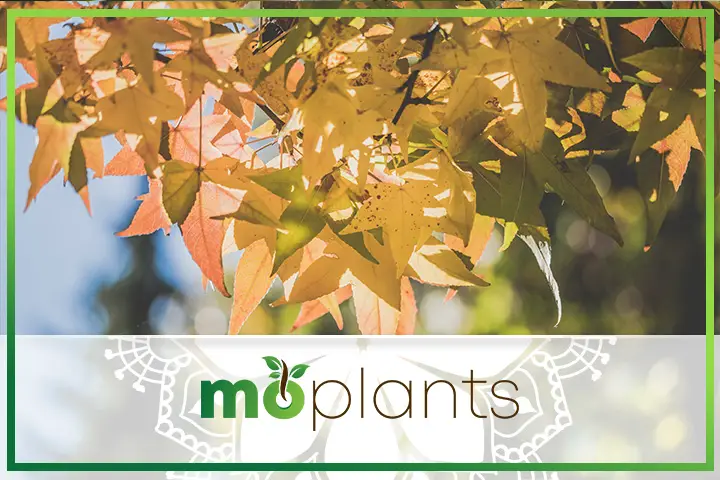
What Else Can You Do To Take Care Of Your Tree?
From the time of planting to maintenance, here are some things you need to look out for in order to make sure that your tree grows healthy and the leaves don’t decay.
Gardening and Planting: Soil Preparation
Since a pomegranate tree can thrive in either acidic or alkaline soil, you won’t have to worry about making any special adjustments before planting your fruit trees. In fact, provided there is sufficient drainage, it may flourish in a wide variety of soil conditions. To the existing potting soil, including sufficient quantities of compost, farmyard dung, and granular tree fertilizer, and then plant the tree seedlings.
A Perfect Temperature
Pomegranate trees originate in the tropics and do best in warm, humid climates. Tolerant of light frost, but extended exposure to cold below 15 degrees farenheit may cause leaf damage and drop. Growing pomegranate trees requires a mild climate, with temperatures between 40 and 90 degrees Fahrenheit being optimal.
Demand for Little Light
Choose a location for your Pomegranate farm where it will get enough sunshine to maximize growth and yields. Fruits that are huge and luscious have to be grown in a hot environment. However, if pomegranate trees are left in the shade for a lengthy period of time, the resulting fruit will be smaller and less juicy.
Consistent and Extensive Watering
A prolonged drought is fatal to any pomegranate tree. It thrives well in moist environments with high humidity. Plants need consistent, deep irrigation, particularly throughout the blooming and fruiting seasons, to produce a healthy crop. However, let the top inch of soil dry out completely between waterings.
Correct Timing of Pruning
At about 2 feet tall, a pomegranate tree is ready for its first round of pruning. The height of a pomegranate tree may range from four to eight meters, depending on the variety. During the colder winter months, whenever the trees are dormant, you may safely clip off the dead limbs.
Try To Avoid Fertilizing
Fertilizer is not required for pomegranate trees. Organic fertilizers and farmyard compost may be added every three months if the soil is weak or lacking in key plant nutrients. Do not apply any chemical fertilizers to the trees when the fruit is maturing.
Insects and Other Diseases
Pests and illnesses seldom affect pomegranates since most varieties are resistant to them. The poor weather conditions bring out the bugs, flies, thrips, and scale insects, which inflict damage and blotches on the leaves. These insects may sometimes produce stains on fruit. If you need to use insecticides or pesticides to keep pests at bay, do it before the fruits reach full maturity.
Dwarf pomegranate trees need the same maintenance as their larger counterparts. Thus, the same care instructions for the standard pomegranate should be applied to the miniature species and bonsai variants. Ripe fruits have a certain hue that lets you know they’re ready to be eaten. Gather them up before the ripened fruits get too soft and break. The longevity of the tree is indeed the primary benefit of having one in your yard. Thus, following fruit setting, there is no pressing need to immediately replace the trees.
Infographic
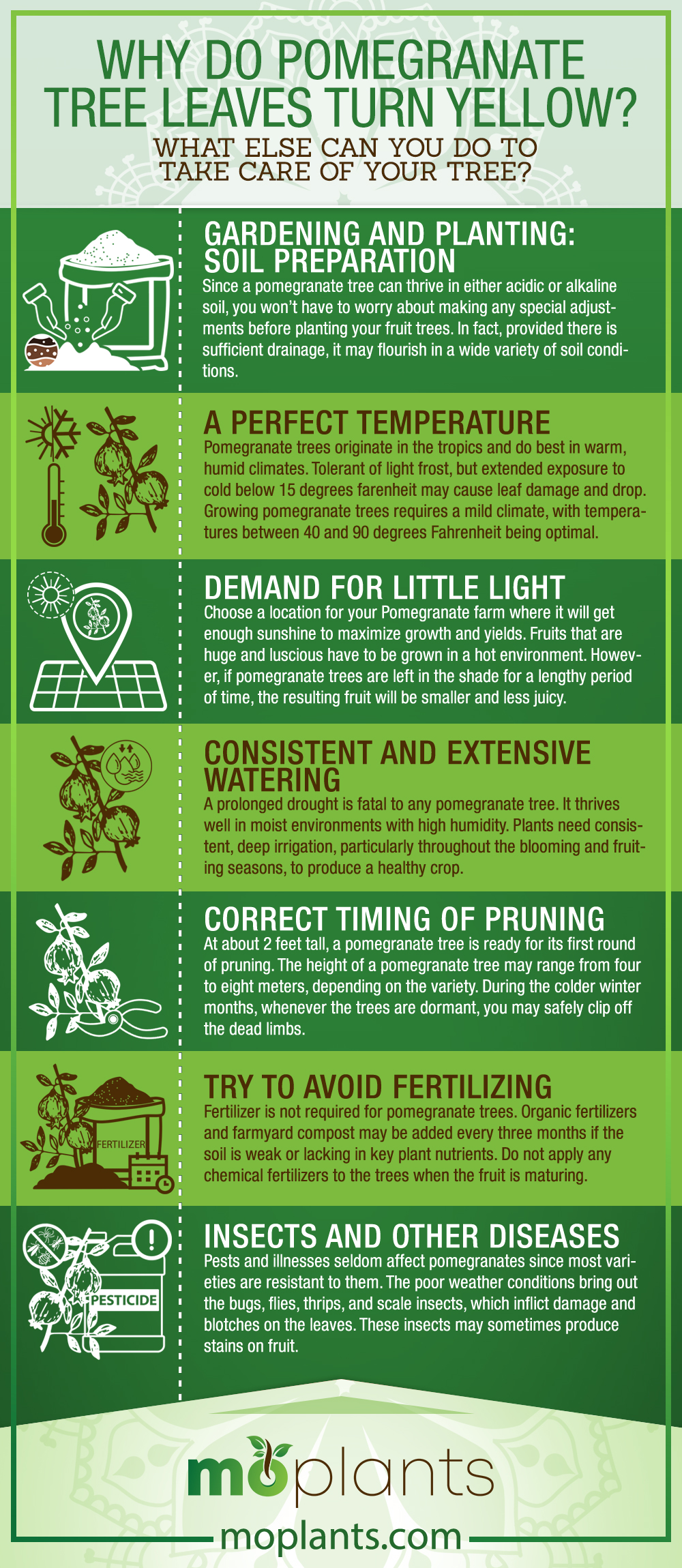
These trees can be a little tricky to take care of. For example, the border between overfeeding and underfeeding pomegranates is thin. Root burn and leaf yellowing happen from applying too much fertilizer; nitrogen shortage and pale green to yellow foliage follow from applying too little. Keep a watchful eye on your tree, and if you see a gradual lightening of the leaf color, give it some food. Feeding the tree soon after bloom might help it produce healthy fruit.
With this guide, you should be able to take care of your pomegranate tree until it reaches full fruition. So the next time the leaves start yellowing, you’ll know exactly what to do.

